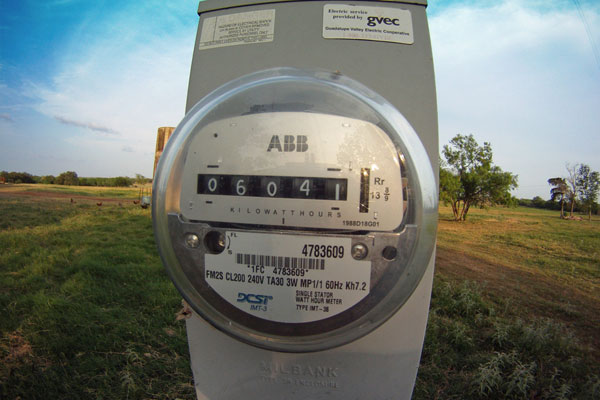
The Illinois Commerce Commission approved ComEd’s request for a rate hike that will cost consumers a little over three dollars a month, it’s estimated. Lisa Madigan has been pounding the utility over the rate hike, leading to concessions from ComEd. But the end game, the implementation of a "smart grid" that would put the onus on consumers to get the three bucks back through decreased usage, might actually be good—for the public generally, if not all consumers individually—in the long run.
Various utilities have been experimenting with consumer-side smart-grid technology for awhile now. In short, the idea is to change from a system in which meter readers provide users with a monthly breakdown of electricity costs, to one in which consumers can monitor their use on a daily (or even more finely-grained basis).
Obviously, anyone can take basic steps to reduce their energy use, and they don’t need a smart grid to do it: hang-drying clothes instead of using the dryer, unplugging energy-consuming devices when they’re not in use, and so forth. You can even read your own analog meter if you want.
And I can see where people might be skeptical: on a small scale, it’s not unlike the switch from pensions to 401k plans, taking a relatively straightforward approach to a basic necessity and turning it into one more damn thing to think about and monitor.
Personally, I’d actually be interested having more convenient access to my energy usage data without having to shell out $40-$215 for specialized energy-monitor devices, which cost the equivalent of one to several months of my energy bill. But I’m a nerd; technology and environmental issues are something I’m generally interested in. I realize not everyone’s like that, so having to exchange extra work for bringing their electricity bills down to their previous level is unappealing, and that’s fine.
Nonetheless, I’m not as tweaked as our attorney general. Here’s why.
In 2010, Canada’s National Research Council released a study of smart-grid experiments throughout North America (PDF). ComEd’s not nearly the first utility to start implementing the technology. Here’s what the average reduction in total electricity use looked like over the time-varying pricing studies the report looked at (things are about to get wonky; if you get bored, skip to the second part):
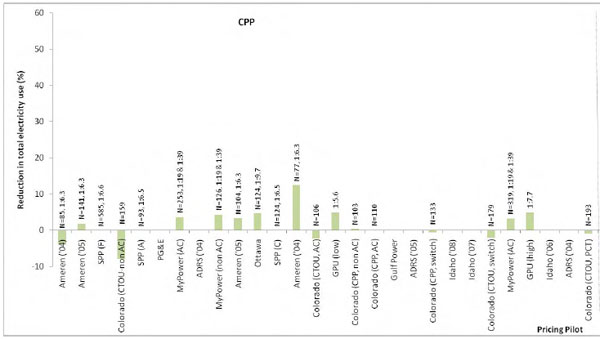
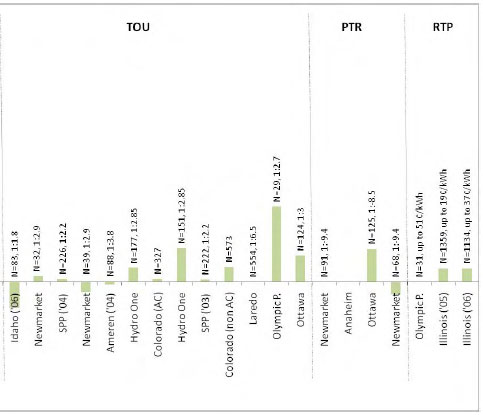
Not all the studies produced total electricity reduction. But the peak demand load reduction was more impressive (the first two images are part of the CPP, or "critical peak pricing" category):
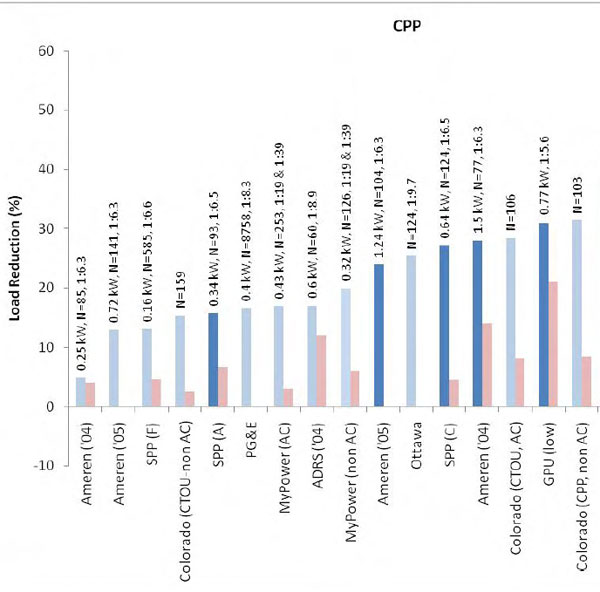
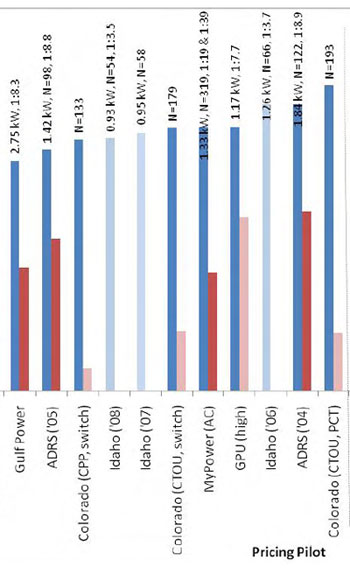
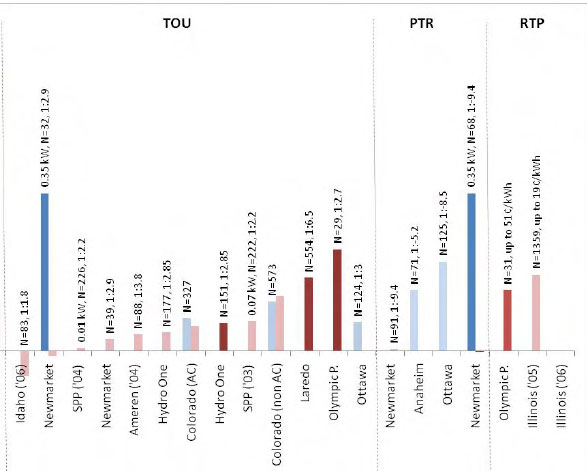
A bit of explanation is in order. CPP (critical peak pricing) means that the rates get jacked up during "event" days. The ratio of off-peak to peak is higher, but the rates don’t go up very often, making it simple to deal with for customers. You get advance notice, you maybe don’t wash clothes or run the dishwasher; it’s straight forward. So the load reduction is very effective.
TOU means "time of use." It’s sort of like critical peak pricing, except the pricing is different during blocks of hours every day. Conceptually simple, but requires a bit more thought to deal with.
PTR is "peak time rebates." It’s more complicated: "Customers receive electricity bill rebates for not using power (relative to previously-established, household specific baseline) during peak periods. In one instance the report cites, the baseline was established with time-of-use rates, and the rebate was established with critical peak pricing.
This is supposed to be simple: "these rate structures are usually designed such that the average customer who does not modify their behavior will pay the same under the new, time-dependent rate structure as they would have under the flat-rate structure." Nonetheless, I still find it confusing: you’re getting a rebate for the theoretical amount to which you don’t use something?
It’s like a double-negative coupon. The authors seem a bit surprised to find it doesn’t work as well as CPP—"one hypothesis is that people respond less well to carrots than sticks in this context"—but even as a fantasy baseball addict accustomed to mathematical projections who should get it, and does on some level, even I find something conceptually disconcerting about it. Can I just buy the use of something? Thanks.
RTP, real-time pricing, is perhaps the most confusing of all: "The price may vary hourly and is tied to the real market cost of delivering electricity. Thus, the price is not known far in advance, no two days have the same rate structure, and there can be much greater extremes of on-peak to off-peak price compared to CPP."
The authors cite an example of an Illinois study where the average price during the summer of 2007 was five cents per kWh, but the two-day peak price was thirty-five cents.
This sounds fun if you like playing the stock market. Otherwise it sounds infuriating. I can imagine the conversations: "Honey, decreased cloud cover today means that we’re paying $0.15/kWh right now. Let’s turn off the cable and read by candlelight." And, the authors note, it can be more expensive to implement.
(The dark-shaded bars represent "enabling technology": "allows the homeowner to choose preferred responses to price signals and then not have to remember to take manual actions on multiple, irregularly scheduled, event days." Obviously, this works better.)
The authors found, and it’s obvious from the graph, that critical peak pricing worked better, probably because it’s simpler. It worked best when combined with enabling technology, because it’s simpler still. Real-time pricing obviously gives users the most flexibility, but that isn’t necessarily a good thing in a utility: it privileges flexible and high-information users, which can often end up being a de facto tax on the poor.
Which the authors actually acknowledge, and to me it’s the most worrisome thing about smart-grid pricing:
Pilot studies often survey participants on their satisfaction with the load reduction strategy’s structure and implementation. It is less common to collect detailed information on the household’s physical and socio‐economic characteristics, and to use these variables as predictors of household load reduction (or satisfaction with the program). Charles River Associates [2005] is one rare example of a study that did do this to some extent…. Among several effects they found, for example, that households with an income of ≥$100,000 reduced peak energy use during a CPP event by 16.2%, whereas the reduction for households with an income of ≤$40,000 was only 10.9%; and, if the head of the household was a college graduate the energy use reduction during a CPP event was 18.5%, as opposed to only 8.6% for non‐graduates.
There are a lot of reasons why this might be the case; I know from personal experience that when my household income was <$40,000, I didn’t have many things that actually used electricity, like an apartment with a washer, dryer, or dishwasher, or a rice cooker, or a DVR, or a television bigger than 20 inches. So my ability to reduce energy usage within the home was curtailed.
And even high-information users can get screwed by variable pricing. I suspect that, in the public’s mind, "real-time pricing" will long be associated with the California energy crisis of 2001. While that’s more a matter of regulation, there’s concern, both instinctual and explicit, that complex energy pricing gives utilities the advantage of information asymmetry. Which is another reason I suspect that the real-time pricing models examined in the report didn’t work well.
In short: the smart grid, on the user end, is basically a tax. And no one likes taxes. Plus it adds another layer of complexity to our day to day lives, making one of the simplest things in the world, monthly electricity bills, more complicated than they used to be.
But that’s, unfortunately, what actually makes the smart grid effective. The smart grid is only "smart" insofar as it provides better data to users, and perhaps makes available enabling technology. The reason it works is that it makes users better aware of the direct cost of their energy usage, from which hopefully follows the indirect cost. And because it provides incentives in the form of "you can have your old energy bill back if you use less energy, or at least use it at different times," it’s essentially trying to enforce different behaviors on customers.
In other words, the purpose of the smart grid and smart meters is to make customers smarter. Which is never a pleasant process. But broadly speaking, it has its benefits.
Photograph: DSebourn (CC by 2.0)



